Module 6 - Guide for Investigating Musculoskeletal Injuries (MSI)
The Canada occupational health and safety regulations list specific requirements to help employers prevent musculoskeletal injuries. This guide provides guidance to help employers, joint health and safety committees, and worker health and safety representatives implement an effective strategy to help prevent musculoskeletal injuries in the workplace. It includes information that will help you to:
- identify factors that place workers at risk;
- understand the steps in preventing injuries;
- understand how control measures can reduce the risk of injuries; and
- investigate injuries and signs or symptoms.
Neck, shoulders, upper back
Ergonomics-related hazard: Lift/lower

1. Do you lift/lower objects that are alive or large or odd-shaped or heavy or unbalanced or that have a shifting centre of gravity, such as a container half filled with water?
Consider the following:
- Eliminate or reduce the need to manually lift, lower or carry objects by using mechanical means such as cranes, hoists and pallet jacks.
- Reduce the distance of the load from the employee by removing any obstacles between the employee and the load so that the employee can move closer to the object.
- Reduce the distance between the load and the employee by moving the load closer to the employee by using a mechanical aid such as a turntable.
- Reduce the overall weight of the load by splitting into smaller loads.
- Use gravity to assist in manual handling by having a lift destination lower than the lift origin.
- Explore and implement ways of reducing the physical demands if the physical demand of the job/task, as is, is not compatible with the employee capability.
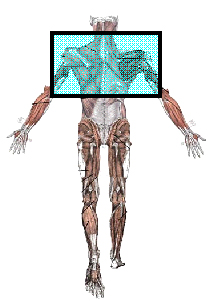
2. Do you lift or lower objects that are difficult to grasp or hold on to?
Consider the following:
- Grasping can be made easier by providing or improving grip/handles on objects being handled.
- Use properly fitting anti-slip gloves.
3. Do you get into an awkward posture (stooping, reaching) when lifting or lowering?
Consider the following:
- Use height adjustable mechanical device, such as a scissor lift, to keep loads off the floor and above knee height.
- Lifts below knee height and above shoulder height can be avoided by adjusting storage shelves, etc.
- Improve work space layout to ensure the employee can handle the loads without getting into a stooped or twisted position.
- Improve the position of the employee and/or the load to reduce the reach distance away from the body to grasp the object.
4. Do you lift objects over a significant height?
Consider the following:
- Starting and ending locations of the lift can be better arranged to reduce the overall vertical travel distance a load has to be lifted. (e.g. modify storage practices, change shelf height, etc.)
5. Do you lift/lower objects while being seated?
Consider the following:
- Establish work procedure to prevent lifting of loads that are heavier than 4 kg when seated (stand and use larger, stronger muscles if lifting heavier objects).
6. Do you perform lifting/lowering tasks repeatedly or frequently?
Consider the following:
- Tasks that are physically demanding can be better organized to ensure they are not performed continually for prolonged periods.
- Use job rotation/enhancement practices and pause periods to permit muscles to recover from applying force for prolonged periods.
Ergonomics-related factor: Carry
7. Do you carry objects that are alive or large or odd-shaped or heavy or unbalanced or that have a shifting centre of gravity, such as a container half filled with water?
Consider the following:
- Carts, motorized buggies, conveyors, gravity feed system, etc. can be used to transport load rather than carrying.
- Use devices/tools such as carrying handles and extension handles to assist with carrying.
- Organize work tasks in order to reduce the carrying distance.
- Housekeeping will ensure the path can be kept clear of obstructions and trip hazards when carrying items.
- Eliminate the work practice of carrying objects up or down stairs while using both hands to hold the object. (Such work practices should not be permitted. Use one hand to hold the hand rail.)
- Reduce the overall weight of the load by splitting into smaller loads. (i.e. manufacturers may have different size options that can be ordered.)
- Work practice of carrying objects on shoulders can be eliminated or made easier by using shoulder pads.
Ergonomics-related factor: Push or pull
8. Do you push or pull objects?
Consider the following:
- Eliminate the need to manually push or pull by using mechanical devices such as conveyors, cranes or gravity fed systems.
- Use larger wheels to enable carts/bins to roll over minor cracks or holes on floor more easily.
- Use wheels/casters that are suitable for the load being transported and are compatible with the type of flooring. (Improve wheels/casters.)
- Pushing will be easier with better swivel arrangement of casters - 2 or 4, front or back.
- Incorporate brakes or improve the existing brakes in the cart so it can be stopped safely and with less physical effort.
- Reduce the physical effort required for pushing by properly maintaining the cart/bin, especially the wheels and wheel bearings.
- Whenever possible, ensure flooring is smooth but not slippery, level, in good condition (no significant cracks or holes), and is clean (no debris).
- Ensure load is stabilized before being pushed or pulled. (e.g. boxes stacked are tilted, not secured).
- Whenever possible, carts, bins, etc. should pulled rather than being pushed.
- Wear suitable footwear for the conditions when performing pushing and pulling.
9. Do you get into awkward postures when pushing (or pulling) objects?
Consider the following:
- Use carts with vertical or height adjustable handles in order to permit grasping the handle in a neutral position (accommodate people of varying heights).
- Increase the space in the work place to allow room for the pushing and pulling to be initiated and maintained in a neutral/comfortable posture.
- Remove visual barriers to reduce twisting or bending parts of the body to see around the cart, bin, etc.
Ergonomics-related factor: Grip force
10. Do you grip or grasp objects using significant force?
Consider the following:
- Eliminate the need for a manual grip by using a mechanical device such as clamps or vice grips.
- Select and use tools/equipment that permits a power grip.
- Use tools that are lighter and designed to reduce hand torque and kickbacks.
- Use tools that are balanced and do not require extra muscular effort to hold it in position.
- Use tools that can be safely used by the left or right hand.
- Improve tool inspection and maintenance so that extra force is not required when using the tool.
- Support the weight of heavy or unbalanced tools by using overhead or under-tool supports.
- Improve work procedure to keep time spent gripping objects to a minimum and the total time spent gripping are broken into shorter periods rather than being continuous.
11. Is awkward posture of the neck or shoulders encountered when gripping tools, equipment or objects?
Consider the following:
- Eliminate/minimize awkward posture by not grasping bulky heavy objects.
Ergonomics-related factor: Repetition
12. Do you perform tasks repeatedly using the same body part without the opportunity for that body part to rest or recover, resulting in fatigue of the soft tissues in that body area?
Consider the following:
- Eliminate or reduce repetitive tasks by mechanization (use of power tools) or by automation.
- Reduce the duration of performing repetitive task through well-designed job rotation or job enhancement (adding variety to the job).
- Greater flexibility can be incorporated into the repetitious task, thereby enabling the employee to control/modify the pace of repetition to prevent adverse effects.
- Utilize micro-breaks to permit adversely affected soft tissues to rest and recover when performing highly repetitious tasks.
- Train employees in improved work techniques in order to reduce unnecessary repetition.
Ergonomics-related factor: Work postures - Awkward posture of the neck
13. Do you perform tasks during which your neck gets into awkward postures frequently for a prolonged period (repetitive twisting or bending of the neck, in any direction)?
Consider the following:
- Reduce/eliminate the glare on a monitor by redesigning the workspace or using a anti-glare screen or proper window treatments.
- Wear proper eyewear when reading (e.g bifocal glasses cause the worker to put their neck in an awkward position, use task specific glasses for viewing a computer screen).
- Position the objects/persons that need to be frequently viewed in front so that twisting of the neck is avoided.
- Keep objects, including computer monitors, which need to be frequently viewed, at a more suitable height that will not require tilting of the head to look up or down.
Ergonomics-related factor: Work postures - Awkward posture of the shoulder
14. Do you perform tasks during which your shoulder gets into awkward postures (elbow away from the side of your torso, in any direction) frequently for a prolonged period?
Consider the following:
- Reduce awkward posture of the shoulder by keeping frequently accessed materials close to avoid excessive reach away from the body in any direction. For example, a tilted work surface (drafting table, tilted material bins) may be a viable option.
- Reduce awkward posture of the shoulder by keeping frequently accessed materials below shoulder height to avoid reaching above shoulder height.
- Avoid reaching behind or across the body by keeping materials that need to be accessed in suitable location in front of employee.
- Establish safe work procedures to reduce awkward posture, such as by moving closer to the object being accessed and transferring objects from one hand to another instead of reaching across the body.
Ergonomics-related factor: Awkward static (fixed) work posture of the neck or shoulders
15. Do you perform tasks during which your neck or shoulder is held in a static (fixed) awkward position for prolonged periods?
Consider the following:
- Static awkward posture of the neck can be reduced by periodically changing position so that the neck is not kept in a static (or fixed) position for a period long enough for the muscles to get "tired".
- Eliminate the need for bending the neck by redesigning the workstation or using assistive devices such as using a hands free telephone headset.
- Static awkward posture of the shoulder can be reduced by periodically changing position so that the shoulder is not kept in a static or fixed position for a period long enough for the muscles to get "tired".
16. Do you experience contact of the neck, shoulder or upper back with an edge?
Consider the following:
- Contact of neck, shoulder or upper back with a sharp/hard edge can be avoided by providing a better work environment or by padding the sharp/hard edges.
- Change or improve work practice to reduce resting of the body part or leaning against sharp edges.
17. Are your neck, shoulders, or upper back exposed to vibration for prolonged periods?
Consider the following:
- Select tools and equipment with lower vibration levels.
- Keep tools and equipment well maintained to minimize vibration.
- Organize the work schedule (e.g. employee rotation) to provide a break from the exposure to vibrations.
- Attempt to dampen some of the vibration of tools by using items such as vibration damping gloves.
18. Are your neck, shoulders, or upper back exposed to cold temperatures when performing physical demanding tasks?
Consider the following:
- Organize the work schedule (e.g. employee rotation) to permit alternative periods of warm work to warm the employee.
- Use suitable clothing and/or provide localized radiant heat.
19. Are your neck, shoulder, or upper back exposed to hot temperatures when performing physical demanding tasks?
Consider the following:
- Organize the work schedule (e.g. employee rotation) to permit alternative periods of cold work to cool the employee.
- Provide shade and sunscreen protection when working outside (heat stress increases fatigue).
- Employees working in hot temperatures should drink enough fluids to keep hydrated (dehydration has a negative effect on muscle performance).
Elbows, forearms and hands
Ergonomics-related hazard: Lift/lower
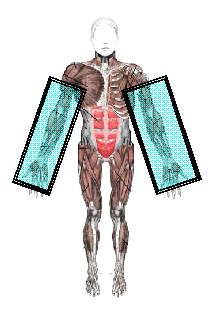
20. Do you lift/lower objects that are alive or large or odd-shaped or heavy or unbalanced or that have a shifting centre of gravity, such as a container half filled with water?
Consider the following:
- Eliminate the need to manually lift, lower or carry objects by using mechanical means such as cranes, hoists and pallet jacks.
- Reduce the distance of the load from the employee by removing any obstacles between the employee and the load so that the employee can move closer to the object.
- Reduce the distance between the load and the employee by moving the load closer to the employee by using a mechanical aid such as a turntable.
- Reduce the overall weight of the load by splitting into smaller loads.
- Use gravity to assist in manual handling by having a lift destination lower than the lift origin.
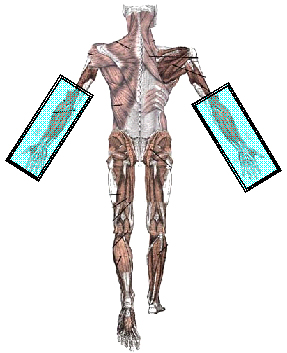
21. Do you lift or lower objects that are difficult to grasp or hold on to?
Consider the following:
- Grasping can be made easier by providing or improving grip/handles on objects being handled.
- Use properly fitting anti-slip gloves.
22. Are your elbows forearms or hands in awkward posture (e.g. forearm rotated, wrist bent) when lifting or lowering?
Consider the following:
- Improve the work space layout and/or the task to ensure the employee can handle the loads without getting the elbows, forearms and wrists into an awkward position (improve the manner in which the object can be accessed).
23. Do you lift objects over a significant height?
Consider the following:
- Reduce the overall vertical travel distance a load has to be lifted by better arranging the starting and ending location of the lift (e.g. modify storage practices, change shelf height, etc.).
24. Do you lift/lower objects while being seated?
Consider the following:
- Establish work procedure to prevent lifting of loads that are heavier than 4 kg when seated (stand and use larger, stronger muscles if lifting heavier objects).
25. Do you perform lifting/lowering tasks repeatedly or frequently?
Consider the following:
- Tasks that are physically demanding can be better organized to ensure they are not performed continually for prolonged periods. (Use job rotation/enhancement practices and pause periods to permit muscles to recover from applying force for prolonged periods.)
Ergonomics-related factor: Carrying
26. Do you carry objects that are alive or large or odd-shaped or heavy or unbalanced or that have a shifting centre of gravity, such as a container half filled with water?
Consider the following:
- Use carts, motorized buggies, conveyors, gravity feed systems, etc. to transport load rather than carrying.
- Use devices/tools such as carrying handles and extension handles to assist with carrying.
- Organize work tasks in order to reduce the carrying distance.
- Housekeeping will ensure the path can be kept clear of obstructions and trip hazards when carrying items.
- Eliminate work practice of carrying objects up or down stairs while using both hands to hold the object. (Such work practices should not be permitted. Use one hand to hold the hand rail.)
- Reduce the overall weight of the load by splitting it into smaller loads (i.e. manufacturers may have different size options that can be ordered.)
Ergonomics-related factor: Push or pull
27. Do you push or pull objects?
Consider the following:
- Eliminate the need to manually push or pull by using mechanical devices such as conveyors, cranes or gravity fed systems.
- Use larger wheels to enable carts/bins to roll over minor cracks or holes on floor more easily.
- Pushing will be easier with better swivel arrangement of casters - 2 or 4, front or back.
- Use wheels/casters that are suitable for the load being transported and are compatible with the type of flooring (improve wheels/casters).
- Incorporate brakes or improve the existing brakes in the cart so it can be stopped safely and with less physical effort.
- Reduce the physical effort required for pushing by properly maintaining the cart/bin, especially the wheels and wheel bearings.
- Whenever possible, ensure flooring is smooth but not slippery, level, in good condition (no significant cracks or holes), and is clean (no debris).
- Whenever possible, carts, bins, etc should pulled rather than being pushed.
- Ensure load is stabilized before being pushed or pulled (e.g. boxes stacked are tilted, not secured).
- Use footwear that is suited for the conditions when performing pushing and pulling.
28. Are your elbows forearms or hands in awkward posture (e.g. forearm rotated, wrist bent) when pushing or pulling?
Consider the following:
- Use carts with vertical or height adjustable handles in order to permit grasping the handle in a neutral position (accommodate people of varying heights).
- Increase the space in the work place to allow room for the pushing and pulling to be initiated and maintained in a neutral/comfortable posture.
- Remove visual barriers to reduce twisting or bending parts of the body to see around the cart, bin, etc.
Ergonomics-related factor: Grip force
29. Do you grip or grasp objects using significant force?
Consider the following:
- Eliminate a manual grip by using a mechanical device such as clamps or vice grips.
- Select and use tools/equipment that permits a power grip and avoid a pinch grip or wide grip span whenever possible.
- Use tools that are lighter and designed to reduce hand torque and kickbacks.
- Use tools with triggers that allow for use of multiple fingers rather than one finger or thumb.
- Use tools that are balanced and do not require extra muscular effort to hold it in position.
- Reduce hand-arm vibration by selecting and using tools with vibration reducing features.
- Support the weight of heavy or unbalanced tools by using overhead or under-tool supports.
- Adding rubber or sponge type grips will facilitate easier gripping of the equipment handle and help in accommodating larger hands.
- Choose tools with handles that fit the hand and do not create pressure points in the palm or fingers of the hand.
- Improve tool inspection and maintenance so that extra force is not required when using the tool.
- Select tools that can be safely used by the left or right hand.
- Improve work procedure to keep time spent gripping objects to a minimum, and the total time spent gripping are broken into shorter periods rather than being continuous.
- Use suitable gloves when grasping cold or vibrating objects.
- Use well-fitting gloves when grasping/gripping objects.
- Use of friction enhanced well-fitting gloves will facilitate gripping.
30. Is awkward posture of the wrist (bent wrist) encountered when gripping tools, equipment or objects?
Consider the following:
- Select and use tools that have handles designed to keep the wrist in a neutral/comfortable position based on the task being performed.
- Further reduce the awkward posture of the wrist by paying special attention to gripping objects with a straight wrist.
Ergonomics-related factor: Repetition
31. Do you perform tasks repeatedly using the same body part without the opportunity for that body part to rest or recover, resulting in fatigue of the soft tissues in that body area?
Consider the following:
- Eliminate or reduce repetitive tasks by mechanization (use of power tools) or by automation.
- Reduce the duration of performing repetitive task through well-designed job rotation or job enhancement (adding variety to the job).
- Greater flexibility can be incorporated into the repetitious task, thereby enabling the employee to control/modify the pace of repetition to prevent adverse effects.
- Micro-breaks can be better utilized to permit adversely affected soft tissues to rest and recover when performing highly repetitious tasks.
- Train employees in better work techniques in order to reduce unnecessary repetition.
Ergonomics-related factor: Work postures - Awkward posture of the wrist and forearm
32. Do you perform tasks during which your wrist or forearm gets into awkward postures frequently for a prolonged period (bending of the wrist in any direction, rotation of the forearm)?
Consider the following:
- Use power tools or mechanical turners to reduce forearm rotations.
- Select and use tools that have handles designed to keep the wrist in a neutral/comfortable position.
- Improve work space layout and/or the task to ensure the employee can handle the loads without getting the forearm and wrists into awkward position (improve the manner in which the object can be accessed).
33. Do you use tools or perform tasks that involve contact stress on your hand(s)?
Consider the following:
- Use of better equipment will reduce contact stress. (e.g. use a long-handled screw driver to prevent the butt from digging into the palm.)
- Use equipment instead of the hand/palm as a hammer.
- Reduce contact stress in the palm by using suitably padded gloves when lifting heavy objects by narrow plastic strapping.
34. Do you work with your hands in a cold environment?
Consider the following:
- Use suitable work practices to keep hands warm, such as wearing suitable gloves.
- Store tools and equipment inside (warm environment) so that the handles are not cold.
- Choose tools that do not discharge cold gases or use personal protective equipment to protect the hands such as gloves or gauntlets.
- Organize the work schedule (e.g. employee rotation) to permit alternative periods of cold and warm work to warm or cool the employee.
Lower back
Ergonomics-related hazard: Lift/lower
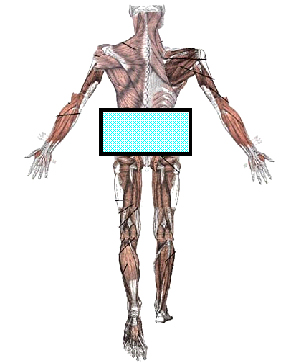
35. Do you lift/lower objects that are alive or large or odd-shaped or heavy or unbalanced or that have a shifting centre of gravity, such as a container half filled with water?
Consider the following:
- Eliminate the need to manually lift, lower or carry objects by using mechanical means such as cranes, hoists and pallet jacks.
- Reduce the distance of the load from the employee by removing any obstacles between the employee and the load so that the employee can move closer to the object.
- Reduce the distance between the load and the employee by moving the load closer to the employee by using a mechanical aid such as a turntable.
- Reduce the overall weight of the load by splitting it into smaller loads.
- Use gravity to assist in manual handling by having a lift destination lower than the lift origin.
- Explore and implement ways of reducing the physical demands if the physical demand of the job/task, as is, is not compatible with the employee capability.
36. Do you lift or lower objects that are difficult to grasp or hold on to?
Consider the following:
- Improve the ease of grasping by providing or improving grip/handles on objects being handled.
37. Do you get into an awkward posture (stooping, reaching) when lifting or lowering?
Consider the following:
- Avoid lifts below knee height and above shoulder height by adjusting storage shelves, etc.
- Use a height adjustable mechanical device, such as a scissor lift, to keep loads off the floor and above knee height.
- Improve the work space to ensure the employee can handle the loads without getting into a stooped or twisted position.
- Reposition the employee and/or the load to further reduce the reach distance away from the body to grasp the object.
38. Do you lift objects over a significant height?
Consider the following:
- Reduce the overall vertical travel distance a load has to be lifted by better arranging the starting and ending locations of the lift. (e.g. modify storage practices, change shelf height, etc.)
39. Do you lift/lower objects while being seated?
Consider the following:
- Establish work procedure to prevent lifting of loads with the lower back in a twisted position.
40. Do you perform lifting/lowering tasks repeatedly or frequently?
Consider the following:
- Tasks that are physically demanding can be better organized to ensure they are not performed continually for prolonged periods.
- Use job rotation/enhancement practices and pause periods to permit muscles to recover from applying force for prolonged periods.
Ergonomics-related factor: Carrying
41. Do you carry objects that are alive or large or odd-shaped or heavy or unbalanced or that have a shifting centre of gravity, such as a container half filled with water?
Consider the following:
- Use carts, motorized buggies, conveyors, gravity feed systems, etc. to transport load rather than carrying.
- Use devices/tools such as carrying handles and extension handles to assist with carrying.
- Organize work tasks in order to reduce the carrying distance.
- Housekeeping will ensure the path can be kept clear of obstructions and trip hazards when carrying items.
- Eliminate the work practice of carrying objects up or down stairs while using both hands to hold the object. (Such work practices should not be permitted. Use one hand to hold the hand rail.)
Ergonomics-related factor: Push or pull
42. Do you push or pull objects?
Consider the following:
- Eliminate the need to manually push or pull by using mechanical devices such as conveyors, cranes or gravity fed systems.
- Use larger wheels on carts/bins to roll over minor cracks or holes on floor more easily.
- Use wheels/casters that are suitable for the load being transported and are compatible with the type of flooring. (Improve wheels/casters.)
- Pushing will be easier with better swivel arrangement of casters - 2 or 4, front or back
- Incorporate brakes or improve the existing brakes in the cart so it can be stopped safely and with less physical effort.
- Whenever possible, carts, bins, etc. should be pulled rather than being pushed.
- Reduce the physical effort required for pushing by properly maintaining the cart/bin, especially the wheels and wheel bearings.
- Whenever possible, ensure flooring is smooth but not slippery, level, in good condition (no significant cracks or holes), and is clean (no debris).
- Ensure load is stabilized before being pushed or pulled. (e.g. boxes stacked are tilted, not secured).
- Use footwear that is suited for the conditions when performing pushing and pulling.
43. Does your lower back get into awkward postures when pushing (or pulling) objects?
Consider the following:
- Use carts with vertical or height adjustable handles in order to permit grasping the handle in a neutral position (accommodate people of varying heights).
- Increase the space in the work place to allow room for the pushing and pulling to be initiated and maintained in a neutral/comfortable posture.
- Remove visual barriers to reduce twisting or bending parts of the body to see around the cart, bin, etc.
Ergonomics-related factor: Repetition
44. Do you perform tasks repeatedly that require physical exertion by the lower back without the opportunity for lower back to rest or recover, resulting in fatigue?
Consider the following:
- Eliminate or reduce repetitive tasks by mechanization or by automation (e.g. automatic stacking machine eliminating the need to repeatedly bend and pick up the product for stacking).
- Reduce the duration of performing repetitive task through well-designed job rotation or job enhancement (adding variety to the job).
- Incorporate greater flexibility into the repetitious task, thereby enabling the employee to control/modify the pace of repetition to prevent adverse effects.
- Utilize micro-breaks to permit lower back to rest and recover when performing highly repetitious tasks.
- Train employees in better work techniques in order to reduce unnecessary repetition.
Ergonomics-related factor: Work postures - Awkward posture of the lower back
45. Do you perform tasks during which your lower back gets into awkward postures frequently for a prolonged period (bending in any direction or twisting of the trunk)?
Consider the following:
- Reduce forward bending of the trunk by raising the work height.
- Reduce forward bending of the trunk can by moving objects being accessed closer.
- Reduce side bending of the trunk by moving objects being accessed closer, or by moving objects to the front of the body.
- Reduce twisting of the truck by improving the layout of the work area.
- Improve seating by adjusting the chair properly to ensure adequate back support and to enable sitting in a good posture.
Ergonomics-related factor: Awkward static (fixed) work posture of the lower back
46. Do you perform tasks during which your lower back is held in a static (fixed) awkward position for prolonged periods?
Consider the following:
- Eliminate or reduce static/awkward posture of the lower back by improving the work place layout.
- Reduce the stress on the lower back from prolonged standing by improving the floor surface such as using anti-fatigue mats.
- Reduce standing by using a sit/stand stool.
- Avoid prolonged standing, especially on a hard surface, by better work procedures and by providing suitable foot rests.
- Use job rotation/enhancement practices and pause periods to permit muscles to recover from prolonged static/awkward posture.
- Avoid prolonged sitting in one position through better work procedures.
- Adverse impact of the static/awkward posture of the lower back can be minimized by providing adequate support to transfer the weight of the torso away from the lower back.
47. Are you exposed to whole body vibration for prolonged periods?
Consider the following:
- Improving seating in large vehicles to reduce vibration (e.g. install shock absorbers).
- Minimize vibration by keeping large tools and equipment well maintained.
- Organize the work schedule (e.g. employee rotation) to provide a break from the exposure to vibrations.
48. Do you perform demanding task where you (whole body) are exposed to a cold environment?
Consider the following:
- Organize the work schedule (e.g. employee rotation) to permit alternative periods of warm work to warm the employee.
- Use suitable clothing and/or provide local radiant heat.
49. Do you perform physical demanding task where you (whole body) are exposed to a hot environment?
Consider the following:
- Organize the work schedule (e.g. employee rotation) to permit alternative periods of cold work to cool the employee.
- Provide shade and sunscreen protection when working outside (heat stress increases fatigue).
- Employees working in hot temperatures should drink enough fluids to keep hydrated (dehydration has a negative effect on muscle performance).
Hips, knees and feet
Ergonomics-related hazard: Lift/lower
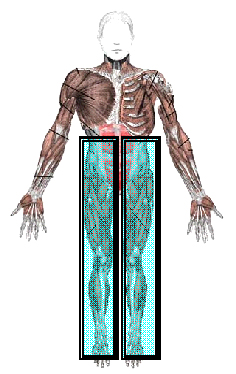
50. Do you lift/lower objects that are alive or large or odd-shaped or heavy or unbalanced or that have a shifting centre of gravity, such as a container half filled with water?
Consider the following:
- Eliminate the need to manually lift, lower or carry objects by using mechanical means such as cranes, hoists and pallet jacks.
- Use gravity to assist in manual handling by having a lift destination lower than the lift origin.
- Reduce the distance between the load and the employee by moving the load closer to the employee by using a mechanical aid such as a turntable.
- Reduce the overall weight by splitting it into smaller loads.
- Reduce the distance of the load from the employee by removing any obstacles between the employee and the load so that the employee can move closer to the object.
Ergonomics-related factor: Carrying
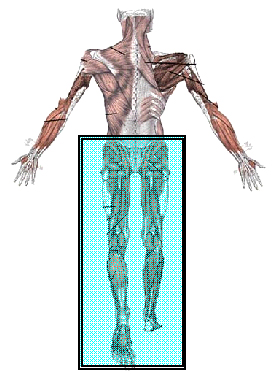
51. Do you carry objects that are alive or large or odd-shaped or heavy or unbalanced or that have a shifting centre of gravity, such as a container half filled with water?
Consider the following:
- Use carts, motorized buggies, conveyors, gravity feed systems, etc. to transport load rather than carrying.
- Eliminate work practice of carrying objects up or down stairs while using both hands to hold the object. (Such work practices should not be permitted. Use one hand to hold the hand rail.)
- Use devices/tools such as carrying handles and extension handles to assist with carrying.
- Housekeeping will ensure the path can be kept clear of obstructions and trip hazards when carrying items.
- Organize work tasks in order to reduce the carrying distance.
- Reduce the overall weight of the load by splitting it into smaller loads (i.e. manufacturers may have different size options that can be ordered.)
Ergonomics-related factor: Push or pull
52. Do you push or pull objects?
Consider the following:
- Eliminate the need to manually push or pull by using mechanical devices such as conveyors, cranes or gravity fed system.
- Use larger wheels to enable carts/bins to roll over minor cracks or holes on floor more easily.
- Use wheels/casters that are suitable for the load being transported and are compatible with the type of flooring. (Improve wheels/casters.)
- Pushing will be easier with better swivel arrangement of casters - 2 or 4, front or back.
- Incorporate brakes or improve the existing brakes in the cart so it can be stopped safely and with less physical effort.
- Reduce the physical effort required for pushing by properly maintaining the cart/bin, especially the wheels and wheel bearings.
- Whenever possible, ensure flooring is smooth but not slippery, level, in good condition (no significant cracks or holes), and is clean (no debris).
- Whenever possible, carts, bins, etc should be pulled rather than being pushed.
- Ensure load is stabilized before being pushed or pulled. (e.g. boxes stacked are tilted, not secured).
- Avoid twisting at the trunk when pushing/pulling.
- Use footwear that is suited for the conditions when performing pushing and pulling.
Ergonomics-related factor: Work postures - Awkward posture of the lower limb
53. Do you perform tasks that require you to work in a squatting or kneeling position?
Consider the following:
- Reduce the need to squat or kneel through better work place layout, by raising the work surface, or through job rotation.
- Use suitable kneepads/padding to protect the knees from contact stress when kneeling on a hard surface.
54. Are your lower limbs exposed to cold temperatures when performing physical demanding tasks?
Consider the following:
- Organize the work schedule (e.g. employee rotation) to permit alternative periods of cold and warm work to warm or cool the employee.
- Use suitable clothing and/or provide localized radiant heat.
55. Are your lower limbs exposed to hot temperatures when performing physical demanding tasks?
Consider the following:
- Organize the work schedule (e.g. employee rotation) to permit alternative periods of cold work to cool the employee.
- Provide shade and sunscreen protection from the sun when working outside (heat stress increases fatigue).
- Employees working in hot temperatures should drink enough fluids to keep hydrated (dehydration has a negative effect on muscle performance).